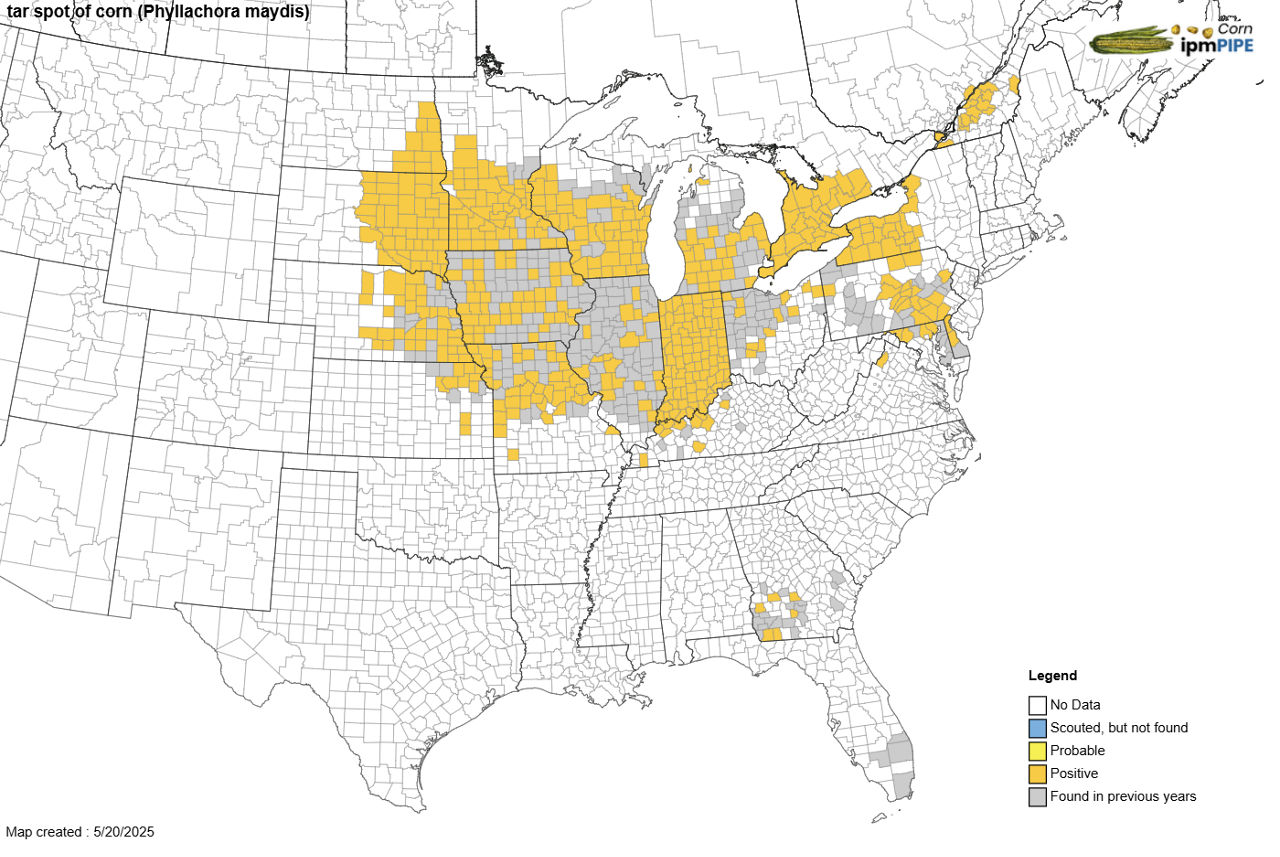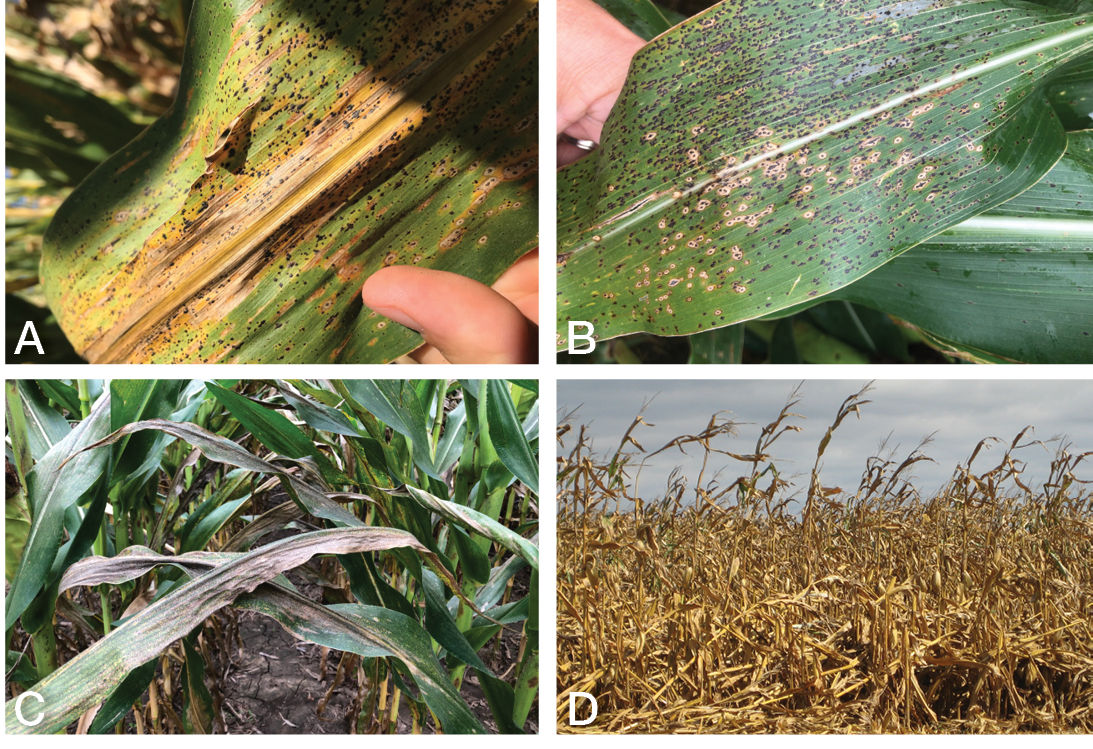What is Tar Spot and How Does it Impact Corn?
September 25, 2025
Tar spot is a fungal disease in corn caused by the pathogen Phyllachora maydis. The disease causes black specks to form on the leaves. In Mexico and Central America, where the disease was discovered, it is referred to as the Tar Spot Complex because of the involvement of a second pathogen found on plants with the disease in that region. The additional pathogen, Monographella maydis, is thought to be responsible for the “fisheye” symptoms that coalesce and cause greater leaf tissue loss. However, the second pathogen has not been confirmed in the United States.

When and how did tar spot get to the United States?
It is theorized that a tropical storm from the Gulf of Mexico in 2015 deposited wind-blown spores to northern Illinois and northern Indiana.
Where can tar spot be found?
Tar spot has been confirmed across a widespread area the central U.S., and in southern Georgia and Florida (Figure 1).
How do I scout corn for tar spot?
Examine corn leaves for the presence of the circular to diamond-shaped, black, tar-like spots, which are slightly raised and feel rough to the touch. The stromata cannot be wiped off the leaf. It is typically observed during or after corn silking through late grain fill (growth stages R1 to R6) but can appear earlier. Occasionally, necrotic brown tissue may surround the black stomata, giving it a fisheye appearance.
What conditions favor tar spot development?
Mild temperatures (59 to 70 °F) and humid conditions (75% relative humidity) with long periods of leaf wetness (greater than 7 hours) are conducive for tar spot development. Wind-driven rain and storms can spread spores of the pathogen to new plants and fields. Research is ongoing to further understand conditions favorable for disease development.
What are the impacts of tar spot?
Like other foliar diseases, the impact of tar spot depends on how early infection occurs and the severity of the infection. Severely infected leaves at grain fill can limit sugar availability resulting in an inability to completely fill ears prior to black layer and an overall loss in kernel weight and yield. When photosynthesis is reduced because of a loss of leaf area, stalks may be cannibalized for sugars, which results in poor standability and lodging. Even in areas where tar spot is present, many fields may not have yield loss because the disease came in late or symptoms did not develop to levels that affect yield. The presence of tar spot does not necessarily indicate a reduction in yield. Yields in fields with tar spot may be reduced by many other stress factors, such as other corn diseases, reduced fertility, or loss of stalk integrity. In some areas, tar spot can be seen progressing in the corn canopy on dead plant tissue following other disease infection or nutrient stress.

How does tar spot start and spread?
The tar spot fungus appears to overwinter in infested crop debris, and the exact means of how the fungus overwinters and the exact way it infects are being studied. Wind-blown or splashing rain likely moves fungal spores from crop debris onto the leaves of the new corn crop, which then becomes infected.
Research from Mexico suggests that the incubation period (the time it takes from infection to visible lesions) may be as long as 40 days. Observations in the U.S. suggest that this period may be only 12 to 15 days under certain circumstances. Like other corn diseases, such as rust, gray leaf spot and northern corn leaf blight, tar spot is polycyclic, meaning that it can produce many generations of spores and infect the crop multiple times within the same season.
Do infected fields have both pathogens?
At this time, Monographella maydis has not been detected in samples of tar spot submitted for testing in the U.S. However, observations in 2018 indicate that the secondary fungus is not required to cause damage to yield potential. P. maydis alone can cause yield loss under favorable environmental conditions. Farmers should monitor fields to help track this disease and determine if management tactics are warranted.
Does tar spot overwinter here?
Because symptoms have been observed in the same areas since 2015, it appears that the fungus is overwintering rather than being reintroduced from Mexico or Central America each year. However, more research is needed to learn how it overwinters, where it does so, if it survives on other alternative hosts, etc.
Are there differences in corn product resistance to tar spot?
While there are no corn products grown in the U.S. Corn Belt that are known to have high levels of resistance to tar spot, there appear to be slight differences among products in levels of susceptibility. Most U.S. corn products across seed brands appear to be relatively susceptible to tar spot, and only a few products appear to have slightly less severe symptoms. Comparing corn product reactions to tar spot, or any disease in isolation, can be tricky. Multiple side-by-side comparisons in fields with uniform levels of disease pressure are best suited for comparing product reactions. Comparing levels of infection between products in different fields may not be accurate. The severity of symptoms can depend on when the infection occurred, the quantity of tar spot fungus that overwintered in infested corn debris in a field, fungicide applications, infection in neighboring fields, and uneven levels of tar spot infection throughout a field can also complicate comparisons.
Does crop rotation help manage tar spot?
Rotation should not make tar spot worse, but it may not provide much control. Because the fungus appears to overwinter in infested debris, avoiding that inoculum early in the season should be beneficial depending on how much inoculum can move in from other sources (e.g., neighboring fields) and how far the spores spread. Based on the widespread occurrence of tar spot in 2018, the fungus appears to spread rapidly over long distances when weather is favorable. In years with less favorable weather, rotation or management of infested debris may be of more value in limiting the development of tar spot. Maintaining plant health throughout the season by reducing stress from lack of nutrients or from other pathogen infection may help reduce risk of yield loss.
Do fungicides help control the disease?
The overall assessment is that fields treated with a fungicide showed less tar spot development than those without. However, fields treated with a fungicide can continue to have some yield loss and standability concerns. It is unclear whether these applications were too late, too early, or simply not frequent enough to control the disease. Susceptible crops that have low tolerance to a disease have historically required multiple fungicide applications to prevent yield loss.
The Crop Protection Network rates Delaro® 325 SC fungicide as good to very good and Delaro® Complete fungicide as very good in fungicide efficacy for control of tar spot in corn. For more information, please visit https://www.cropscience.bayer.us/d/delaro-325-sc-fungicide for Delaro® 325 SC fungicide and https://www.cropscience.bayer.us/d/delaro-complete-fungicide for Delaro® Complete fungicide and contact your retailer. Fungicide application should begin when disease first appears and continue at 7 to 14-day intervals as long as growing conditions persist that favor continued disease development. More than one fungicide application may be needed in growing conditions with high disease pressure.
Sources
Smith, K. 2019. Crop Disease Management: Tar Spot. CPN-2012. Crop Protection Network. https://cropprotectionnetwork.org/encyclopedia/tar-spot-of-corn.
Quinn, D. and Telenko, D. 2022. Tar spot of corn: What to know and new research. Purdue University Extension. https://extension.entm.purdue.edu/newsletters/pestandcrop/article/tar-spot-of-corn-what-to-know-and-new-research/.
Paul P., Dalia F., and Silva L. 2019. Tar Spot of Corn in Ohio Again this 2019. 2019-35. C.O.R.N. Newsletter. Ohio State University Extension. https://u.osu.edu/henryag/2019/10/22/tar-spot-of-corn-in-ohio-again-this-2019/.
Corn Disease Working Group. 2025. Fungicide efficacy for control of corn foliar diseases. Crop Protection Network. https://cropprotectionnetwork.org/publications/fungicide-efficacy-for-control-of-corn-diseases/.
1211_130805